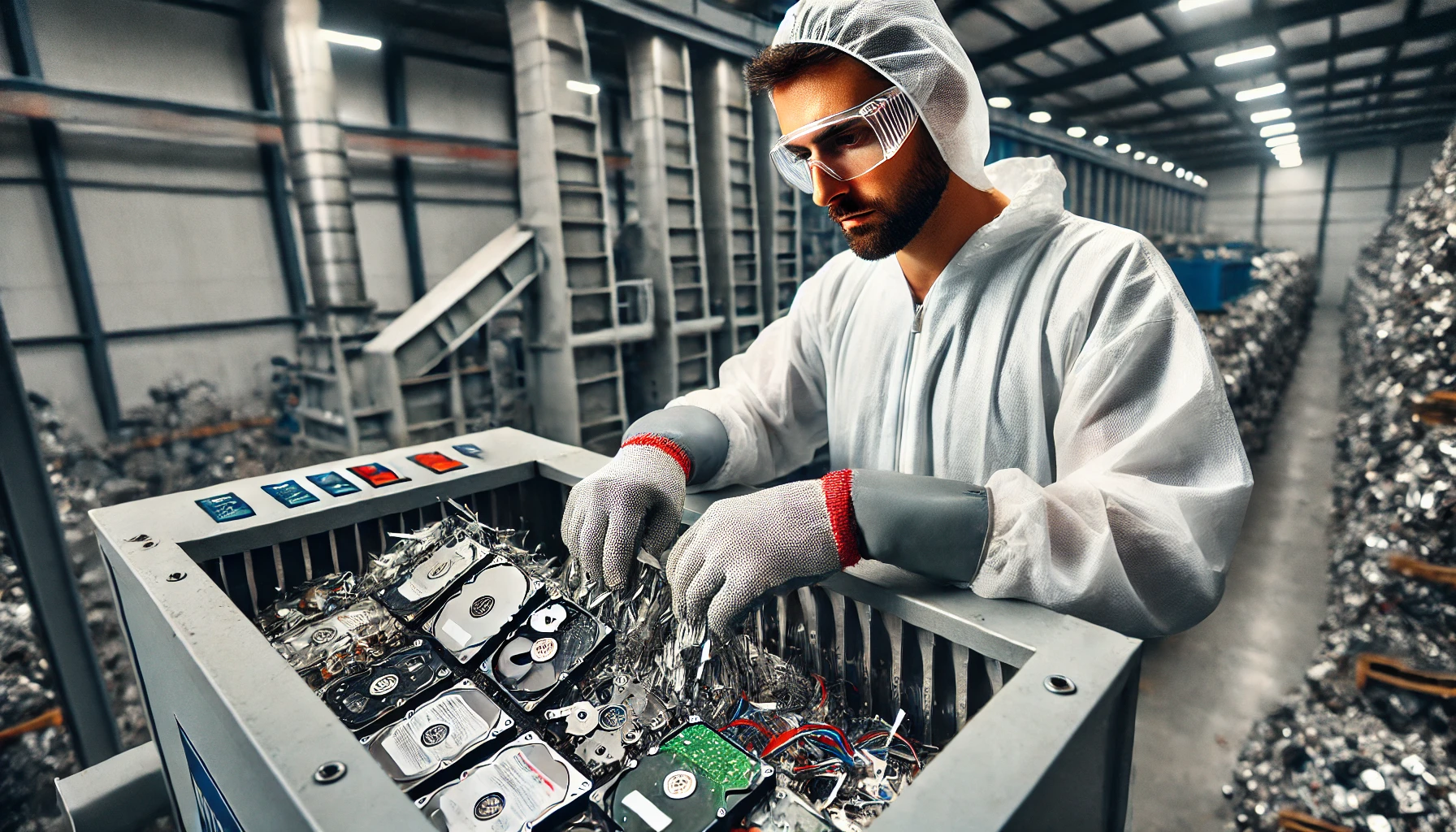Disposing of outdated hard drives requires more than simply deleting files—it demands secure destruction to protect sensitive data.
Whether dealing with traditional hard drives or modern SSDs, understanding the importance of hard drive shredding is key to maintaining data privacy.
This article delves into the various types of hard drives, key factors to consider, and the most effective shredding techniques.
It also highlights the importance of proper disposal and recycling to ensure environmental responsibility while keeping your information safe. Read on to learn how to secure your data the right way.
Why is Hard Drive Shredding Important?

Hard drive shredding is a vital procedure for maintaining data privacy and preventing data breaches, ensuring that sensitive information is rendered irrecoverable upon disposal. As organisations increasingly depend on digital storage solutions, the significance of secure deletion through data shredding has grown considerably.
This practice safeguards against unauthorised access and potential misuse of sensitive data. Adopting this proactive approach not only enhances digital security but also aligns with compliance and regulatory standards, thereby protecting both personal and corporate information from unauthorised exposure.
Types of Hard Drives for Shredding
A comprehensive understanding of the various types of hard drives is essential for implementing effective shredding protocols, as each type exhibits distinct characteristics and data retention risks.
The two primary categories, Solid State Drives (SSDs) and Hard Disk Drives (HDDs), differ in their data storage technologies, performance metrics, and lifespans. SSDs utilise solid-state technology, providing superior transfer speeds and reliability, while HDDs depend on magnetic media and typically offer larger storage capacities.
Both types are therefore pertinent in discussions regarding data shredding and data recovery processes.
Traditional Hard Drives
Traditional hard drives, commonly referred to as hard disk drives (HDDs), utilise magnetic media for data storage and are recognised for their substantial storage capacities and cost-effectiveness. While HDDs offer considerable advantages in terms of data retention, their performance metrics frequently fall short when compared to Solid State Drives (SSDs), particularly regarding transfer speeds and overall efficiency.
For users with significant storage requirements and budget constraints, HDDs continue to be a viable option, especially when accompanied by effective data shredding and data sanitisation techniques.
These drives consist of spinning disks, or platters, coated with a magnetic material that enables data reading and writing as the platters rotate. This construction allows HDDs to store large volumes of information at a lower cost per gigabyte, making them attractive for extensive data archives.
However, the mechanical nature of HDDs also presents disadvantages, such as susceptibility to physical damage and slower data access times, which can impede performance during intensive tasks.
In the context of data shredding, it is crucial to acknowledge that HDDs require specific, often more thorough, erasure methods to ensure complete data destruction, due to their layered storage structure.
Solid State Drives (SSDs)
Solid State Drives (SSDs) have transformed data storage capabilities through their solid-state technology, delivering exceptional performance and reliability in comparison to traditional Hard Disk Drives (HDDs). With significantly faster transfer speeds and reduced power consumption, SSDs meet the demands of users seeking efficiency and advanced data recovery solutions.
As these drives gain widespread adoption, it is essential to understand their distinct characteristics, particularly concerning data shredding practices that facilitate secure deletion while addressing the specific challenges presented by SSDs.
Plus enhancing overall computing speed, SSDs demonstrate superior durability due to the absence of moving parts that can degrade over time, rendering them more resistant to physical shock. This durability contributes to their reliability, especially in portable devices subject to frequent movement. The data management methods employed in SSDs introduce complexities in data shredding; traditional overwriting techniques often prove inadequate because of wear-leveling processes.
Consequently, users must implement specialised data destruction strategies specifically designed for SSDs to achieve comprehensive data sanitisation. This underscores the importance of being informed about appropriate disposal methods to uphold data security.
Factors to Consider When Choosing a Hard Drive for Shredding

Selecting the appropriate hard drive for shredding involves several critical factors, including security considerations, data erasure methods, and the environmental implications of disposal practices.
Organisations must ensure compliance with industry standards regarding data destruction while also assessing the effectiveness of various data sanitisation techniques, such as physical shredding, software shredding, and encryption.
A thorough understanding of these factors is essential for maintaining data integrity, minimising vulnerabilities, and adhering to regulatory requirements throughout the data lifecycle.
Security and Data Erasure
Security and data erasure are critical components of the shredding process, as effective measures guarantee the permanent removal of sensitive information, rendering it irretrievable.
This significance is further emphasised by the growing scrutiny organisations face regarding their data management practices. Implementing techniques such as overwriting—where existing data is replaced multiple times with random information—provides an additional layer of protection.
Moreover, encryption acts as a strong defence mechanism, making data unintelligible to unauthorised users, even in the event of attempted recovery. By adopting these practices, organisations not only strengthen their defenses against potential breaches but also ensure alignment with compliance standards, thereby mitigating legal risks and demonstrating a commitment to the protection of sensitive information.
Environmental Impact
The environmental impact of hard drive shredding is an increasingly significant consideration, as improper disposal can result in hazardous waste and the wastage of valuable resources. Organisations are encouraged to adopt recycling practices that adhere to industry standards for electronics recycling, thereby ensuring effective data destruction while promoting environmental sustainability.
By comprehending the implications of their disposal methods, companies can contribute to a greener digital landscape while maintaining compliance with legal regulations.
It is essential for businesses to recognise that outdated or damaged hard drives may contain sensitive information, making the destruction process not merely a regulatory obligation but also a moral imperative. Utilising certified e-waste recycling services can substantially reduce the risk of environmental harm, as these facilities comply with stringent guidelines that ensure safe material handling.
Incorporating a circular economy approach enables organisations to recover valuable metals and components, thereby decreasing the necessity for new resource extraction. By prioritising responsible hard drive shredding practices, companies not only safeguard critical data but also play an instrumental role in fostering an eco-friendly environment.
Methods of Hard Drive Shredding

Organisations can employ several effective methods of hard drive shredding to ensure data sanitisation and secure deletion. Physical destruction methods, such as shredding and crushing, are widely utilised as they guarantee that data cannot be retrieved.
Additionally, degaussing, which disrupts magnetic fields, proves to be effective for hard disk drives (HDDs). Furthermore, specialised shredding services offer comprehensive solutions for various types of drives, ensuring compliance with data destruction regulations.
Physical Destruction
Physical destruction is one of the most effective methods for ensuring data sanitisation, as it involves the complete dismantling of hard drives through processes such as shredding or crushing. This procedure renders data irretrievable, making it a preferred option for organisations that prioritise data security.
It is essential to consider hardware compatibility and potential environmental impacts when implementing physical destruction methods.
Organisations seeking to adopt this approach must ensure that their hardware, including both SSDs and HDDs, can endure the physical destruction process without compromising surrounding equipment. Adequate disposal techniques should be established to responsibly manage the remnants of destroyed devices.
By utilising certified e-waste recycling programmes, organisations can mitigate their ecological footprint while achieving the assurance that sensitive information has been securely eliminated.
Ultimately, integrating physical destruction with environmentally sound practices can enhance data protection while also supporting sustainability initiatives.
Degaussing
Degaussing is a specialised data destruction technique that disrupts the magnetic fields of hard disk drives (HDDs), effectively rendering stored data irretrievable. While this method is notably effective for older magnetic media, it is important to recognise that it is not applicable to Solid State Drives (SSDs), which operate on different storage technologies. Organisations must comprehend the limitations and advantages of degaussing to effectively incorporate it into their data destruction strategies.
The degaussing process employs a powerful magnet to eliminate data stored on HDDs, positioning it as one of the most secure methods for protecting sensitive information prior to disposal. By generating a magnetic field significantly stronger than that of the drive itself, degaussing effectively scrambles the data, making traditional recovery techniques ineffective.
It is essential to emphasise that while degaussing is proficient in erasing data from HDDs, it is inadequate for SSDs, which utilise flash memory for information storage.
As organisations strive for comprehensive data destruction, understanding these distinctions ensures a well-rounded approach that maximises the benefits of degaussing while exploring alternative solutions for SSDs, such as physical destruction or cryptographic erasure.
Shredding Services
Utilising shredding services can significantly enhance an organisation’s data destruction processes by offering professional, compliant, and environmentally responsible solutions for secure data deletion. These services are specialised in ensuring that hard drives are securely shredded in accordance with industry standards for data destruction and recycling.
By entrusting this vital task to experts, businesses can effectively protect sensitive information from unauthorised access while aligning their operations with regulatory requirements, such as GDPR and HIPAA. Compliance with these regulations is essential in today’s data-driven environment, where the legal consequences of negligence can be considerable.
Reputable shredding companies emphasise environmental stewardship by ensuring that shredded materials are recycled and diverted from landfill. This dual emphasis on security and sustainability not only safeguards the organisation’s reputation but also reinforces its commitment to ethical practices in data management.
Best Practices for Hard Drive Shredding

Implementing best practices for hard drive shredding is essential for ensuring data security and compliance with industry regulations. Organisations should establish comprehensive protocols for the disposal and recycling of hard drives, which include effective methods for data sanitisation and secure deletion that prioritise data privacy.
By adhering to these best practices, companies not only protect sensitive information but also support environmentally responsible recycling initiatives.
Disposal and Recycling Options
Selecting appropriate disposal and recycling options for hard drives is essential for ensuring effective data destruction while minimising environmental impact. Organisations should consider certified e-waste recycling programmes that adhere to industry standards, ensuring compliance with relevant regulations and responsibly managing electronic waste. By prioritising these practices, companies can safeguard sensitive data and contribute to a sustainable digital landscape.
Plus seeking certified recyclers, it is crucial for organisations to implement a comprehensive data destruction policy that includes physical destruction methods, such as shredding or degaussing, when necessary. Training employees on the importance of data security and environmental responsibility is also vital in fostering a culture of compliance.
By actively engaging in responsible disposal methods, companies not only protect their data but also demonstrate their commitment to reducing their carbon footprint and promoting a circular economy. Ultimately, integrating these best practices can enhance reputation and trust among stakeholders, ensuring long-term corporate success.
Frequently Asked Questions
What are the different types of hard drives used for shredding?
There are several types of hard drives that are commonly used for shredding, including standard HDDs, solid-state drives (SSDs), hybrid drives, and external drives.
What makes a hard drive suitable for shredding?
A hard drive is suitable for shredding if it contains sensitive and confidential data, and is no longer in use or needed. This ensures that all data is completely destroyed and cannot be recovered.
Can all types of hard drives be shredded?
Yes, any type of hard drive can be shredded as long as it is no longer functional and contains confidential data. It is important to check with the shredding company for their specific capabilities and procedures.
What is the difference between shredding a hard drive and wiping it?
Shredding a hard drive involves physically destroying the device, making it impossible to retrieve any data. Wiping a hard drive, on the other hand, simply erases the data but the device remains intact and can potentially be recovered.
Why is it important to properly dispose of hard drives?
Properly disposing of hard drives ensures that sensitive data does not fall into the wrong hands. This can prevent identity theft, data breaches, and other forms of cybercrime. It also helps protect the environment by properly disposing of electronic waste.
How should I choose a reliable shredding company for my hard drives?
When choosing a shredding company, make sure they are certified and have a secure chain of custody for handling and destroying sensitive data. It is also important to inquire about their procedures for disposing of shredded materials and their level of compliance with data protection laws.

